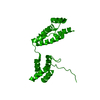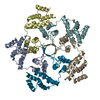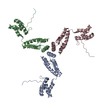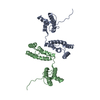+Search query
-Structure paper
| Title | PNMA2 forms immunogenic non-enveloped virus-like capsids associated with paraneoplastic neurological syndrome. |
|---|---|
| Journal, issue, pages | Cell, Vol. 187, Issue 4, Page 831-845.e19, Year 2024 |
| Publish date | Feb 15, 2024 |
 Authors Authors | Junjie Xu / Simon Erlendsson / Manvendra Singh / G Aaron Holling / Matthew Regier / Iosune Ibiricu / Jenifer Einstein / Michael P Hantak / Gregory S Day / Amanda L Piquet / Tammy L Smith / Stacey L Clardy / Alexandra M Whiteley / Cédric Feschotte / John A G Briggs / Jason D Shepherd /    |
| PubMed Abstract | The paraneoplastic Ma antigen (PNMA) proteins are associated with cancer-induced paraneoplastic syndromes that present with an autoimmune response and neurological symptoms. Why PNMA proteins are ...The paraneoplastic Ma antigen (PNMA) proteins are associated with cancer-induced paraneoplastic syndromes that present with an autoimmune response and neurological symptoms. Why PNMA proteins are associated with this severe autoimmune disease is unclear. PNMA genes are predominantly expressed in the central nervous system and are ectopically expressed in some tumors. We show that PNMA2, which has been co-opted from a Ty3 retrotransposon, encodes a protein that is released from cells as non-enveloped virus-like capsids. Recombinant PNMA2 capsids injected into mice induce autoantibodies that preferentially bind external "spike" PNMA2 capsid epitopes, whereas a capsid-assembly-defective PNMA2 protein is not immunogenic. PNMA2 autoantibodies in cerebrospinal fluid of patients with anti-Ma2 paraneoplastic disease show similar preferential binding to spike capsid epitopes. PNMA2 capsid-injected mice develop learning and memory deficits. These observations suggest that PNMA2 capsids act as an extracellular antigen, capable of generating an autoimmune response that results in neurological deficits. |
 External links External links |  Cell / Cell /  PubMed:38301645 / PubMed:38301645 /  PubMed Central PubMed Central |
| Methods | EM (single particle) |
| Resolution | 3.2 - 3.3 Å |
| Structure data | EMDB-19024, PDB-8rb3: EMDB-19025, PDB-8rb4: EMDB-19026, PDB-8rb5: EMDB-19027, PDB-8rb7: |
| Source |
|
 Keywords Keywords |  VIRUS LIKE PARTICLE / Endogenous retrovirus. PNMA2 / PNMA / Paraneoplastic syndrome / Paraneoplastic antigen Ma2 / VLP. VIRUS LIKE PARTICLE / Endogenous retrovirus. PNMA2 / PNMA / Paraneoplastic syndrome / Paraneoplastic antigen Ma2 / VLP. |
 Movie
Movie Controller
Controller Structure viewers
Structure viewers About Yorodumi Papers
About Yorodumi Papers












